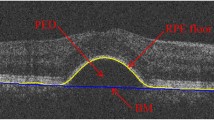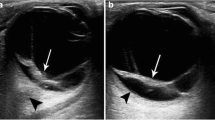Abstract
This paper presents a novel method for automated detection of retinal detachment from ocular ultrasound image using digital image processing and computational techniques. Retinal detachment (RD) is an ocular emergency in which retina gets detached from the tissues lying underneath it and often requires immediate intervention to prevent rapid, irreversible vision loss. Direct fundoscopy and visual field testing are most common methods for the detection of RD. These methods are difficult to perform and they do not completely rule out retinal detachment. Generally, Ophthalmologists use ocular ultrasound to enhance their clinical acumen in detecting RD. Sometimes it is difficult to extract diagnostic features from ultrasound (USG) images due to its poor quality. Also, noise present in the image would cause misinterpretation during visual inspection;this demands development of intelligent and automated techniques for detection of retinal detachment. Further, the paper proposes a novel frame work for accurate and automatic retinal detachment using image processing techniques and mathematical analysis of detached area contour detected within the ocular globe. Furthermore, the estimation of diagnostic parameters, indicative of retinal detachment is also computed. Based on the mathematical analysis, three such parameters, percentage area of detached retina (PADR) compared to the ocular globe, angular width of detachment (α) and maximum radial distance of detachment to choroid layer beneath it (β), are calculated. These estimated parameters are very useful in determining the exact location and extent of retinal detachment. Results obtained through the proposed retinal detachment detection scheme are validated by the radiologist.


















Similar content being viewed by others
References
Blumenkranz MS, Byrne SF (1982) Standardized echography (ultrasonography) for the detection and characterization of retinal detachment. Ophthalmology 89(7):821–831
Chang HJ, Lynm C, Golub RM (2012) Retinal Detachment. JAMA 307(13):1447. https://doi.org/10.1001/jama
Chee YA, Mokhtar MM, Al-Ashwal RH, Supriyanto E (2012) Image Processing Analysis for Ultrasound Retinal Detachment Images. In: Pavelkova et al. (eds) Advances in Environment, Biotechnology and Biomedicine pp. 355-360
Coleman DJ, Jack RL (1973) B-scan ultrasonography in diagnosis and management of retinal detachments. Arch Ophthalmol 90(1):29–34
Damianidis CH et al (2010) Magnetic Resonance Imaging and Ultrasonographic Evaluation of Retinal Detachment in Orbital Uveal Melanomas. Neuroradiol J 23(3):329–338
Jaffe GJ, Caprioli J (2004) Optical coherence tomography to detect and manage retinal disease and glaucoma. Am J Ophthalmol 137(1):156–169
Jalali S, Santhamma K (2003) Retinal detachment. Commun Eye Health 16(46):25-26
Jorgensen E (1996) Sonographic Diagnosis of Reteinal Detachnents A Literary Review. J Diagn Med Sonography 12(6):287–294
Kahn A et al (2005) Retinal Detachment diagnosed by bedside ultrasound in the emergency department. Calif J Emerg Med 6(3):47
Lu H, Li Y, Chen M, Kim H, Serikawa S (2018) Brain Intelligence: Go beyond artificial intelligence. Mobile Networks and Application 23(2):368-375
Lu H, Li B, Zhu J, Li Y, Xu X, He L, Li X, Li J, Serikawa S (2017) Wound Intensity Correction and Segmentation with Convolutional Neural Networks. Concurrency and Computation: Practice and Experience, 29(6). https://doi.org/10.1002/cpe.3927
Lu H, Li Y et al (2018) Low Illumination Underwater Light Field Images Reconstruction using Deep Convolutional Neural Networks. Futur Gener Comp Syst. https://doi.org/10.1016/j.future.2018.01.001
Michels RG, Wilkinson CP, Rice TA (1990) Retinal detachment. The C.V. Mosby Company, Maryland Heights, p 17
Morajab S, Zarkandy S (2015) An Intelligent Method Based On Hough Transform and Support Vector Machine to Diagnose Retinal Detachment in Ultrasound Images. Int Res J EngTechnol(IRJET), 02(09):731–735
Serikawa S, Lu H (2014) Underwater Image Dehazing Using Joint Trilateral Filter. Comput Electr Eng 40(1):41–50
Shinar Z, Chan L, Orlinsky M (2011) Use of ocular ultrasound for the evaluation of retinal detachment. J Emerg Med 40(1):53–57
Vrablik ME et al (2015) The diagnostic accuracy of bedside ocular ultrasonography for the diagnosis of retinal detachment: a systematic review and meta-analysis. Ann Emerg Med 65(2):199–203
Author information
Authors and Affiliations
Corresponding author
Rights and permissions
About this article
Cite this article
Gupta, R., Gupta, V., Kumar, B. et al. A novel method for automatic retinal detachment detection and estimation using ocular ultrasound image. Multimed Tools Appl 79, 11143–11161 (2020). https://doi.org/10.1007/s11042-018-6032-3
Received:
Revised:
Accepted:
Published:
Issue Date:
DOI: https://doi.org/10.1007/s11042-018-6032-3




